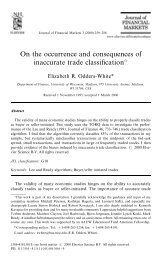A generic framework for Arabic to English machine ... - Acsu Buffalo
A generic framework for Arabic to English machine ... - Acsu Buffalo
A generic framework for Arabic to English machine ... - Acsu Buffalo
You also want an ePaper? Increase the reach of your titles
YUMPU automatically turns print PDFs into web optimized ePapers that Google loves.
4.4.2.2 Homograph<br />
4.4. LINGUISTIC ASPECTS OF MT<br />
The second type of lexical ambiguity occurs when a word can have two or more differ-<br />
ent meanings. Linguists distinguish between homographs, homophones and polysemes.<br />
Homographs are two (or more) ‘words’ with quite different meanings which have the<br />
same spelling: example, light (not dark or not heavy). Many <strong>Arabic</strong> words can have two<br />
or more overlapping meanings examples; ֓i֒lān could be announcement, advertisement,<br />
declaration or sign. Also, <br />
mrkz could be centre, position, rank or status.<br />
Moreover, mwq֒ could be position, rank, site or status. The direct approach has<br />
particular problems with homographs; the usual method of resolving homograph ambi-<br />
guities is <strong>to</strong> look at the closest words <strong>for</strong> clues.<br />
4.4.3 Syntactic ambiguity<br />
Syntactic ambiguity arises when there is more than one way of analysing the underlying<br />
structure of a sentence according <strong>to</strong> the grammar used in the system. Example, I know a<br />
man with a dog who has fleas, is ambiguous. It could be the man or the dog who has fleas.<br />
It is the syntax not the meaning of the words which is unclear. The classical example is<br />
He saw the girl with the telescope. For the purposes of this discussion, we represent these<br />
examples in the notation of a context-tree grammar rather than in RRG notation.<br />
The two trees in Figure 4.5 and Figure 4.6 represent the two different analyses in the<br />
sense of recording two different ‘parse his<strong>to</strong>ries’. In linguistic terms, they correspond <strong>to</strong><br />
the two readings of the sentence: one in which the PP is part of the NP (i.e. the girl has<br />
the telescope), and the other where the PP is the same level as the subject (i.e. the man<br />
has the telescope). For convenience, a bracketed notation <strong>for</strong> trees is sometimes used:<br />
the equivalents <strong>for</strong> the trees in Figure 4.5 and Figure 4.6 are shown in (4.1a) and (4.1b)<br />
respectively.<br />
58
















